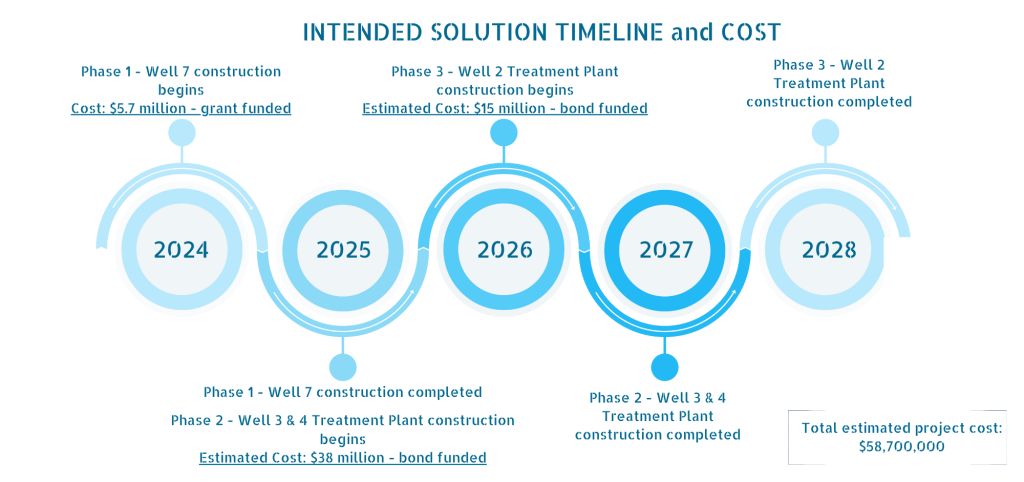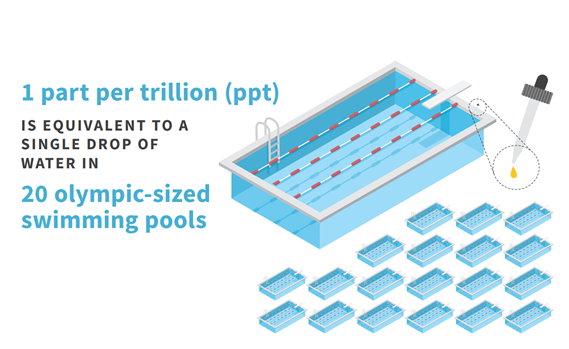General PFAS Information
We are committed to providing consumers with safe and reliable water and are working diligently to develop a plan that ensures the public water supply meets the new drinking water standards. We will keep the public informed as we work with the state to develop, design and implement the most expedient, effective and fiscally responsible solution to this emerging chemical of concern.
North Park Water has already completed several projects to ensure safe drinking water is supplied to the community. The implementation of the full intended solution is estimated at approximately $58,700,000. North Park Water is pursuing several different funding opportunities to limit the impact of the solution on our rates. To date, North Park Water has been granted $5.7 million towards the project through the IEPA State Revolving Loan, Principal Forgiveness Program. This award will be similar to a grant and does not need to be repaid.
North Park Water has already completed several projects to ensure safe drinking water is supplied to the community. The implementation of the full intended solution is estimated at approximately $58,700,000. North Park Water is pursuing several different funding opportunities to limit the impact of the solution on our rates. To date, North Park Water has been granted $5.7 million towards the project through the IEPA State Revolving Loan, Principal Forgiveness Program. This award will be similar to a grant and does not need to be repaid.
Timeline of Solution Implementation:
- Late 2020: First samples indicate some PFAS in source water.
- 2021: North Park Water begins study to identify Sources and Solutions to PFAS Proactive measures to monitor PFAS levels through quarterly sampling begin.
- 2022: Sources and Solutions Study is completed Based on the results of the study, North Park Water purchases additional land for potential treatment plant.
- 2023: A pilot study to determine the best treatment method begins North Park Water begins and completes the design of an additional well (Well 7) - estimated project cost: $5.7 million
- 2024: North Park Water Board approves the Final Design contract for the treatment plant Received Grant funding in the amount of $5.7 million for the construction of Well 7
North Park Water Board approves a contract for Pre-Design of Treatment Plant
Application is submitted to IEPA to request funding through the State Revolving Loan Program
Submitted the first treatment plant to IEPA to request funding through the State Revolving Loan Program
Future Steps:
- 2024: Construction of Well 7 begins.
Final design of the treatment plant to be completed
- 2025: Construction of first treatment plant to begin, estimated project cost: $38 million
- 2026: Construction of second treatment plant to begin, estimated project cost: $15 million
- 2027: Construction of first treatment plant to be completed
- 2028: Construction of second treatment plant to be completed

More Resources on PFAS:
North Park Water Sample Results
| PFAS Analyte | Acronym | Analytical Result at TP03/Well 3 (ppt) | Analytical Result at TP04/Well 4 (ppt) |
|---|---|---|---|
| Perfluorooctanoic acid | PFOA | ND - 3.5 | 2.4 - 4.9 |
| Perfluorooctanesulfonic acid | PFOS | 2.5 - 4.2 | 3.7 - 7.0 |
| Perfluorohexanesulfonic acid | PFHxS | ND - 3.0 | 3.6 - 7.5 |
| Perfluorononanoic acid | PFNA | ND | ND - 2.1 |
| Perfluorobutanesulfonic acid | PFBS | ND - 3.3 | 2.7 - 5.0 |
| Hexafluoropropylene oxide-dimer acid | HFPO-DA | ND | ND |
| Perfluorohexanoic acid | PFHxA | ND | ND - 3.0 |

ND: not detectable at testing limit.
What are PFAS?
Per- and poly-fluoroalkyl substances are a group of thousands of chemicals collectively known as PFAS. Since the 1940s, PFAS have been used in manufacturing, firefighting, water- and oil-resistant products, and many consumer products such as carpet, clothing, cosmetics, and food packaging. Two of the most common compounds within this class, perfluorooctanoic acid (PFOA) and perfluorooctanesulfonic acid (PFOS), stopped being produced in the United States (U.S.) in the early 2000s, but these compounds may still be present in imported goods.
PFAS are present in many consumer goods, including food packaging and personal care products, and scientists have found levels of PFAS in the blood of nearly all individuals tested. Exposure to high levels of PFAS over time may cause adverse health effects such as increased cholesterol levels, increased risk for thyroid disease, low infant birth weights, reduced response to vaccines, pregnancy-induced hypertension and increased risk of liver and kidney cancer as seen in studies of laboratory animals. Exposure to PFAS above the recommended screening levels does not mean that a person will get sick or an adverse health effect will occur, screening levels are conservative estimates. The possible health effects of PFAS are dependent on how much a person is exposed to and how long they are exposed to it. Exposure to PFAS above recommended screening levels for periods of time may mean that a person is at a greater risk of experiencing these adverse effects.
PFAS are present in many consumer goods, including food packaging and personal care products, and scientists have found levels of PFAS in the blood of nearly all individuals tested. Exposure to high levels of PFAS over time may cause adverse health effects such as increased cholesterol levels, increased risk for thyroid disease, low infant birth weights, reduced response to vaccines, pregnancy-induced hypertension and increased risk of liver and kidney cancer as seen in studies of laboratory animals. Exposure to PFAS above the recommended screening levels does not mean that a person will get sick or an adverse health effect will occur, screening levels are conservative estimates. The possible health effects of PFAS are dependent on how much a person is exposed to and how long they are exposed to it. Exposure to PFAS above recommended screening levels for periods of time may mean that a person is at a greater risk of experiencing these adverse effects.
Background
Under the Safe Drinking Water Act, EPA has the authority to set enforceable National Primary Drinking Water Regulations (NPDWRs) for drinking water contaminants and require monitoring of public water systems. In 2016, U.S. EPA adopted a Lifetime Health Advisory for PFOA and PFOS of 70 parts per trillion (ppt), both individually and combined when both are present. This is a non-enforceable value intended to provide guidance for evaluating unregulated drinking water contaminants. In March 2021, EPA published Regulatory Determinations for Contaminants on the Fourth Contaminant Candidate List which included a final determination to regulate PFOA and PFOS in drinking water. As a part of that final determination, EPA indicated it would also evaluate additional PFAS and consider regulatory actions to address groups of PFAS.
On March 24, 2023, EPA proposed the PFAS NDPWR. Concurrent with the proposed rule, EPA also announced preliminary regulatory determinations for PFHxS, PFNA, HFPO-DA, and PFBS in accordance with the Safe Drinking Water Act regulatory development process. EPA proposed to regulate PFOA and PFOS with individual MCLs and PFHxS, PFNA, HFPO-DA, and PFBS using a Hazard Index which accounts for co-occurring mixtures of these four PFAS. Concurrent with the final PFAS NPDWR announced on April 10, 2024, EPA also announced final individual regulatory determinations for PFHxS, PFNA, and HFPO-DA, and final regulatory determination for mixtures containing two or more of these three PFAS and PFBS. This regulation will also remove many other PFAS when they co-occur with these regulated PFAS.
On April 10, 2024 US EPA finalized a National Primary Drinking Water Regulation (NPDWR) establishing legally enforceable levels, called Maximum Contaminant Levels (MCLs), for six PFAS in drinking water. PFOA, PFOS, PFHxS, PFNA, and HFPO-DA as contaminants with individual MCLs, and PFAS mixtures containing at least two or more of PFHxS, PFNA, HFPO-DA, and PFBS using a Hazard Index MCL to account for the combined and co-occurring levels of these PFAS in drinking water. EPA also finalized health-based, non-enforceable Maximum Contaminant Level Goals (MCLGs) for these PFAS.
The final rule requires:
On March 24, 2023, EPA proposed the PFAS NDPWR. Concurrent with the proposed rule, EPA also announced preliminary regulatory determinations for PFHxS, PFNA, HFPO-DA, and PFBS in accordance with the Safe Drinking Water Act regulatory development process. EPA proposed to regulate PFOA and PFOS with individual MCLs and PFHxS, PFNA, HFPO-DA, and PFBS using a Hazard Index which accounts for co-occurring mixtures of these four PFAS. Concurrent with the final PFAS NPDWR announced on April 10, 2024, EPA also announced final individual regulatory determinations for PFHxS, PFNA, and HFPO-DA, and final regulatory determination for mixtures containing two or more of these three PFAS and PFBS. This regulation will also remove many other PFAS when they co-occur with these regulated PFAS.
On April 10, 2024 US EPA finalized a National Primary Drinking Water Regulation (NPDWR) establishing legally enforceable levels, called Maximum Contaminant Levels (MCLs), for six PFAS in drinking water. PFOA, PFOS, PFHxS, PFNA, and HFPO-DA as contaminants with individual MCLs, and PFAS mixtures containing at least two or more of PFHxS, PFNA, HFPO-DA, and PFBS using a Hazard Index MCL to account for the combined and co-occurring levels of these PFAS in drinking water. EPA also finalized health-based, non-enforceable Maximum Contaminant Level Goals (MCLGs) for these PFAS.
The final rule requires:
- Public water systems must monitor for these PFAS and have three years to complete initial monitoring (by 2027), followed by ongoing compliance monitoring. Water systems must also provide the public with information on the levels of these PFAS in their drinking water beginning in 2027. North Park Water has been monitoring for these PFAS since 2020.
- Public water systems have five years (by 2029) to implement solutions that reduce these PFAS if monitoring shows that drinking water levels exceed these MCLs. Based on the intended solution timeline, North Park Water will have the initial solution implemented within 3 years (by 2027).
- Beginning in five years (2029), public water systems that have PFAS in drinking water which violates one or more of these MCLs must take action to reduce levels of these PFAS in their drinking water and must provide notification to the public of the violation.
What are the potential health concerns associated with PFAS exposure?
Studies indicate that exposures to high levels of PFAS contaminated water over time may cause certain adverse health effects. Exposure to PFAS above the recommended screening levels does not necessarily mean that a person will get sick or an adverse health effect will occur. Research on the health effects associated with PFAS is ongoing.
Scientific studies of laboratory animals, as well as studies on human populations exposed to PFOA and PFOS over periods of time, have shown that exposure to PFOA and PFOS above certain levels may result in adverse effects such as:
• increased cholesterol levels
• changes in liver enzymes
• decreased response to vaccines in children
• increased risk of high blood pressure or pre-eclampsia in pregnant women
• small decreases in infant birth weight
• increased risk of kidney or testicular cancer
If you have specific health concerns, please consult your health care professional.
Scientific studies of laboratory animals, as well as studies on human populations exposed to PFOA and PFOS over periods of time, have shown that exposure to PFOA and PFOS above certain levels may result in adverse effects such as:
• increased cholesterol levels
• changes in liver enzymes
• decreased response to vaccines in children
• increased risk of high blood pressure or pre-eclampsia in pregnant women
• small decreases in infant birth weight
• increased risk of kidney or testicular cancer
If you have specific health concerns, please consult your health care professional.
